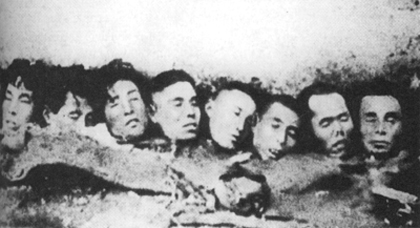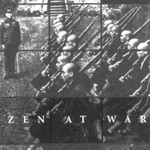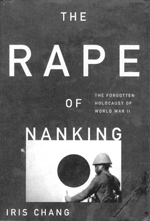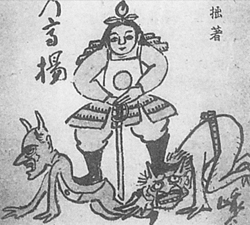Zen at War
Brian Victoria
Weatherhill: New York, 1997
228 pp. $19.95 (paper)
The Rape of Nanking: The Forgotten Holocaust of World War II
Iris Chang
Basic Books: New York, 1997
290 pp., $25.00 (cloth)

Think of “holy wars,” and Western religions come to mind. The God of Exodus orders the extermination of the Caananites, instructing his chosen people to “show them no pity.” The commandment “Thou shalt not kill” did not apply to slaying Gentiles. In 1095, Pope Urban II ordered Crusaders to Jerusalem to “kill the enemies of God.” In two days, Christian soldiers slaughtered 40,000 Muslims who were merely non-human “filth.” “Wonderful sights,” one Crusader reported. “Piles of heads, hands, and feet. It was a just and splendid judgment of God that this place should be filled with the blood of unbelievers.”
On the other hand, Buddhism has always been portrayed as the religion of peace. When the Shakya kingdom was threatened with invasion, the Buddha sat in meditation in the path of the soldiers. When the Dharma came to Tibet, it is said that the barbaric tribes were pacified. During the Vietnam War, Buddhist monks set themselves on fire to protest the killing.
 will radically shake up this view of Buddhism. Brian Victoria, a western Soto Zen priest and instructor at the University of Auckland, reveals the inside story of the Japanese Zen establishment’s dedicated support of the imperial war machine from the late 1800s through World War II. With unsparing detail, Victoria chronicles how prominent Zen leaders perverted the Buddhist teaching to encourage blind obedience, mindless killing, and total devotion to the emperor. It would be convenient to dismiss Victoria’s revelations as a Japanese wartime aberration that is long past and could never happen again. That would be a mistake. There is a lot to learn here that could have profound effects as we grow as a Buddhist sangha in the West.
will radically shake up this view of Buddhism. Brian Victoria, a western Soto Zen priest and instructor at the University of Auckland, reveals the inside story of the Japanese Zen establishment’s dedicated support of the imperial war machine from the late 1800s through World War II. With unsparing detail, Victoria chronicles how prominent Zen leaders perverted the Buddhist teaching to encourage blind obedience, mindless killing, and total devotion to the emperor. It would be convenient to dismiss Victoria’s revelations as a Japanese wartime aberration that is long past and could never happen again. That would be a mistake. There is a lot to learn here that could have profound effects as we grow as a Buddhist sangha in the West.
Buddhism became the state religion of Japan under Tokugawa rule (1600-1868). During that time, nearly half a million temples were built and the Buddhist priesthood became an extension of the feudal government. But such wealth and power generated resentment, and by the time of the Meiji era in 1868, a movement began to reinstate Shinto as the only true Japanese tradition. Thousands of temples were closed, statues destroyed and priests forcibly returned to lay life. The only way institutional Buddhism could survive was to become part of the new imperial regime.
Under the Shinto banner, the emperor was worshiped as a living god—“the selfless wisdom of the universe.” Imperial law and the Dharma were seen as identical—“Imperial-way Zen” as opposed to the “Buddha-way Zen.” According to Victoria, the emperor replaced the Buddha, the Japanese spirit and loyalty replaced the Dharma, and the nation replaced the Sangha. A famous “Zen soldier” wrote, “Seeking nothing at all, you should simply completely discard both body and mind, and unite with the emperor.”
With the Sino-Japanese War and the Japanese victories in China and Korea and later successes in the Russo-Japanese War (1904-1905), national pride swelled, and Japan yearned to be a “first-class nation”—a modern world power that could counter Western expansion and create its own empire. Japan saw itself as divine, racially and culturally superior, “flawless,” and “the only Buddhist country.” Non-Japanese were called “jama gedo”—unruly heathens.
Victoria traces the integration of Japanese Zen history with samurai culture and bushido, the way of the sword. For hundreds of years, Zen masters trained samurai warriors in meditation, teaching them enhanced concentration and willpower. Zen helped them face adversity and death with no hesitation, to be totally loyal and to act unimpeded by thinking. The sword had long been a Buddhist symbol for cutting through delusion, but under bushido it was used literally, evolving from metaphor into an object of veneration and obsession, idealized and worshiped.
Victoria pinpoints Shaku Soen (1859-1919) as one of the first Zen Masters to enthusiastically embrace war as Zen training. Well known as D. T. Suzuki’s teacher, Soen was the first Zen teacher to visit the United States, arriving in Chicago in 1893 to attend the World Parliament of Religions. In the war against Russia, Soen served as a chaplain and wrote: “In the present hostilities into which Japan has entered with great reluctance, she pursues no egotistic purpose, but seeks the subjugation of evils hostile to civilization, peace and enlightenment.” (In fact, Japan’s invasion of Russia was entirely self-serving and hardly reluctant.) To Soen, Japan was engaged in a “holy” and “just” war, a “war of compassion” fought by bodhisattva soldiers against the enemies of Buddha. Furthermore, war was “an inevitable step toward the final realization of enlightenment.”
Sawaki Kodo (1880-1965), one of the great Soto patriarchs of this century, was, according to Victoria, another evangelical war proponent. Serving in Russia as a soldier, he happily related how he and his comrades had “gorged ourselves on killing people.” Later, in 1942, he wrote, “It is just to punish those who disturb the public order. Whether one kills or does not kill, the precept forbidding killing [is preserved]. It is the precept forbidding killing that wields the sword. It is the precept that throws the bomb.”
The “precept throws the bomb”? This is an astonishing abuse of Zen language. Kodo also advocated, as did other Zen teachers, that if killing is done in a state of no-mind or no-self, then the act is an expression of enlightenment. No thinking = No-mind = No-self = No karma. In this bizarre equation, the victims are always left out, and real killing becomes an elegant expression of the koan. Victoria has brought to light the actual words of these leaders and the written record of this period. Zen at War contains dozens of passages from leading teachers, proving that this distortion was the rule, not the exception. There were some pacifists, but they were few.
D. T. Suzuki’s early writing reflected the influence of Soen’s teachings. In 1896, as the war with China began, he wrote: “Religion should, first of all, seek to preserve the existence of the state.” Like his teacher, he saw the enemies of Japan as “unruly heathens” who needed to be tamed and conquered or who would otherwise “interrupt the progress of humanity. In the name of religion, our country could not submit to this.” Going to war he called “religious conduct.”
Using poetic language in praise of Japanese soldiers, D. T. Suzuki said, “Our soldiers regard their own lives as being as light as goose feathers while their devotion to duty is as heavy as Mount Taishan [in China]. Should they fall on the battlefields, they have no regrets.” This metaphor of “goose feathers” would become a major point of military indoctrination, teaching recruits and the young kamikaze (“divine wind”) pilots that their individual lives were meaningless and had no weight. Only total devotion to the emperor would give their existence meaning.
In Victoria’s relentless pursuit of making public the efforts of the Zen war machine, we learn that the Soto sect raised money for two fighter planes, Soto I and Soto II. Not to be outdone, the Rinzai head temple Myoshinji contributed three fighter planes to the imperial navy. The Bodhisattva of Compassion, Kanzeon, was officially renamed “Kanzeon Shogun” and invoked to bring greater victory in the “holy war.” (This would be the equivalent of renaming Jesus Christ “General Jesus.”)
By 1940, D. T. Suzuki began to change his tune, but in 1937, in Zen and Japanese Culture, he wrote that Zen “treats life and death indifferently” and “is a religion that teaches us not to look backward once the course is decided.” He stated further that Zen “has no special doctrine or philosophy. It is therefore extremely flexible in adapting itself to almost any philosophy and moral doctrine as long as its intuitive teaching is not interfered with.” Zen can be “wedded to anarchism or fascism, communism or democracy . . . or any political or economic dogmatism.”
As Suzuki wrote these words, Japanese troops were marching towards the ancient city of Nanking. They were indeed going to act out the Zen bushido creed and “treat life and death indifferently.” They did not look back. In December 1937, the Japanese army seized the city, then the capital of the Republic of China. Japan was in its sixth year of its invasion of China. Japan had already conquered Peking and Shanghai.
 Iris Chang, whose grandparents escaped the city just before it fell, has written a brilliant and chilling account of this terrible war chapter. The Rape of Nanking: The Forgotten Holocaust of World War II finally chronicles a catastrophe that many Japanese still deny ever happened.
Iris Chang, whose grandparents escaped the city just before it fell, has written a brilliant and chilling account of this terrible war chapter. The Rape of Nanking: The Forgotten Holocaust of World War II finally chronicles a catastrophe that many Japanese still deny ever happened.
The Japanese invaders took full control of the city on December 13. In seven short weeks, they engaged in “an orgy of cruelty seldom if ever matched in world history.” They brutally murdered, raped, and tortured as many as 350,000 Chinese civilians. In this bloodbath, more people died than at Hiroshima and Nagasaki combined. For months, the city was filled with piles of rotting corpses.
Nearly 80,000 women were raped and mutilated, many gang-raped. Soldiers disemboweled women. Fathers were forced to rape their daughters, sons their mothers. All manner of inhuman torture was practiced without remorse. Children and the elderly were not spared. Thousands of young men were beheaded, burned alive, or used for bayonet practice.
Japanese leaders had been demonizing the Chinese for decades as the “unruly heathens” Soen and Suzuki had spoken of. As one commander preached to his unit: “You must not consider the Chinese as human beings, but only as something of rather less value than a dog or a cat.” The Chinese were also referred to as “pigs” and “raw materials.” The barbarism was so intense that even the Nazis in the city were horrified, one declaring the slaughter to be the product of a “bestial machinery.” Chang recounts the following incident:
“In teaching new Japanese soldiers how to behead Chinese civilians, Tominaga Shozo recalled how Second Lieutenant Tanaka instructed his group. ‘Heads should be cut off like this,’ he said, unsheathing his army sword. He scooped water from a bucket with a dipper, then poured it over both sides of the blade. Swishing off the water, he raised his sword in a long arc. Standing behind the prisoner, Tanaka steadied himself, legs spread apart, and cut off the man’s head with a shout, ‘Yo!’ The head flew more than a meter away. Blood spurted up in two fountains from the body and sprayed into the hole. The scene was so appalling that I felt I couldn’t breathe.”
With this image in mind, consider the following passage that D. T. Suzuki wrote at the same time as the Nanking massacre:

In the light of Nanking, Suzuki’s writing is grotesque. The spiritual justification for killing and mass brutality is undeniably the worst perversion of religion imaginable. It is truly deplorable that Zen could devolve from the great meditation tradition of the Bodhisattva Path into a glorification of slaughter as a great work of art.
Many historians have had difficulty understanding the Japanese brutality in Nanking. Zen at War provides some significant missing pieces to helping us comprehend the underlying mind of the Japanese military, while Chang’s gripping investigation provides us with the actual consequences of the twisted religious philosophy that fueled the Japanese military.
Chang writes: “Some Japanese soldiers admitted it was easy for them to kill because they had been taught that next to the emperor, all individual life—even their own—was valueless.” The Japanese soldier Azuma Shiro reported that during his two years of military training, “. . . he was taught that ‘loyalty is heavier than a mountain, and our life is like a feather.’. . . to die for the emperor was the greatest glory, to be caught alive by the enemy the greatest shame. ‘If my life was not important, an enemy’s life became inevitably much less important. . . . This philosophy led us to look down on the enemy and eventually to the mass murder and ill treatment of captives.’”
This total betrayal of compassion did not take place just during World War II. For centuries, Zen was intimately involved in the way of killing. Not all temples or all teachers were involved, but this aspect was a significant part of Zen culture. In Zen at War, the most excessive situations uncover distortions that had existed for centuries.
The Buddha said that to understand everything is to forgive everything. What happened in Japan must be explored fully, so it can be both understood and transformed. Zen master Hakuin taught: “Where there is thorough questioning there will be a thoroughgoing experience of awakening.”
For many Zen students, the most difficult aspect of Victoria’s haunting book will be how to face the words and actions of these highly esteemed Zen masters. How can we absorb these overwhelming contradictions? These were the living Buddhas of the Zen tradition—men regarded as “fully enlightened,” who had satori experiences, underwent intense training, received the official transmission and teaching seals. Many were brilliant charismatic teachers and koan masters. And at the same time, these same Zen masters were swept away in nationalist delusion, perverted Buddhist and Zen teachings, and exhibited a total lack of compassion and wisdom. They participated directly in the deaths of tens of millions of people.
We must ask these questions even if they are difficult—perhaps impossible—to answer. It is essential to know the shadows of the spiritual traditions we follow. In the light of Zen at War, shadows can have enormous harmful potential, and The Rape of Nanking attests to the terrible consequences.
We need to know the mechanics of how the Buddha Way can turn into this horrific form of heartless Zen. This is not about orthodoxy or purity; it is about compassion and insight. This is not about condemning the Japanese, but about how we, as one sangha, can help one another to awaken authentically. For the Buddhist world, Victoria has written a brave book that confronts our most cherished and idealized views of Buddhism. But Victoria limits his investigation to philosophical perversions; he leaves us shocked, whereas Chang’s compelling account confirms that to ignore Victoria’s work, is to do so at our peril.